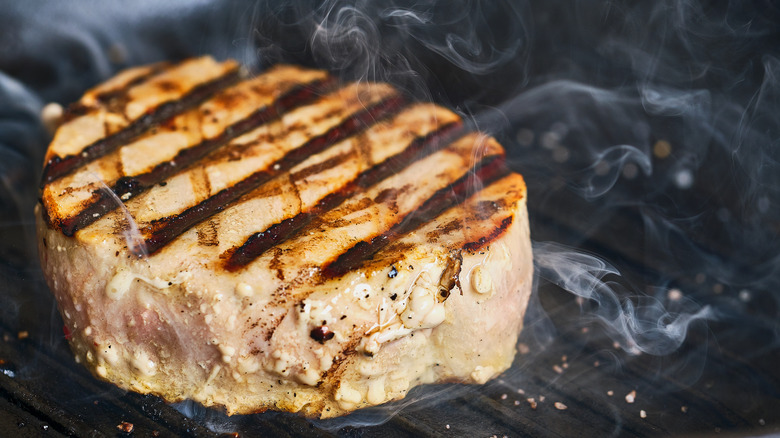The Correct Temperature For Cooking Tuna Steak
Tuna steaks are a great-tasting, nutritious option that even holds up against other well-loved fish like salmon. Canned tuna can be a great option to keep in your pantry, but when you want something a little more fresh, there is nothing like a perfectly seared tuna steak.
One of the hardest qualities of cooking with tuna steaks is their moisture content. It's always important to make sure that any meat is brought to a safe temperature for consumption before eating it. According to the Food and Drug Administration (FDA), that means above 145 degrees Fahrenheit for fish. You also have to worry about your steak drying out though if you cook it too long.
Because tuna is such a lean cut of meat, it doesn't have as much fat to keep it from drying out during the cooking process. As BBC Good Food notes, this means that the perfect sweet spot between dangerously undercooked, and a dry, crumbly mess is a pretty narrow sliver when it comes to tuna steaks.
Tuna steaks only need a quick sear
Thermoblog reports that one of the keys to bringing a tuna steak to the proper temperature is to ensure that it has a proper thermal mass. It recommends buying a tuna steak that is at least an inch thick and keeping it refrigerated until just before cooking it. The cooler temperature will add some protection to the tuna's interior and make it harder to overcook. Picking tuna loins with consistent red coloring is also important to ensure that your steak is fresh.
Thermoblog then recommends bringing a pan or skillet to approximately 425 degrees Fahrenheit before adding the steak. Omaha Steaks recommends cooking the steak so that only the outside is seared, while much of the interior is uncooked. In Japanese cuisine this method is known as the Tataki method, according to Fine Dining Lovers. To achieve this method, Thermoblog recommends cooking steaks for just over a minute on each side. Steaks should be removed from the heat when the internal temperature reaches 65 degrees Fahrenheit. This is because it found that internal temperature can rise as much as 25 degrees Fahrenheit while resting so this will bring your steak to a final temperature of 90 degrees Fahrenheit after being set aside for a few minutes.
This is lower than the FDA's recommended safe temperature, and does pose some risks, but it is the ideal temperature for a perfectly moist interior that elevates all of the tuna's natural flavors.

